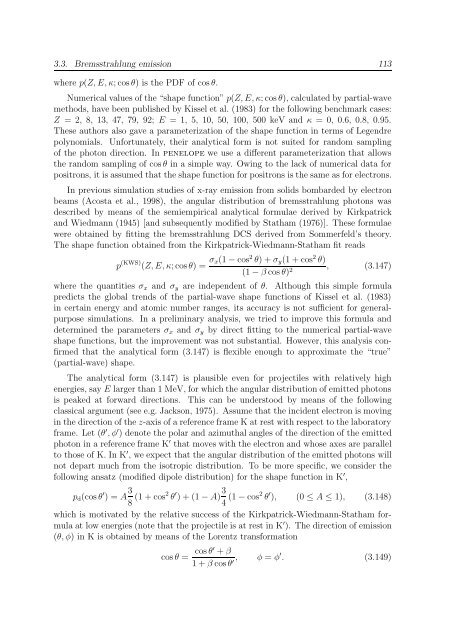PENELOPE 2003 - OECD Nuclear Energy Agency
PENELOPE 2003 - OECD Nuclear Energy Agency
PENELOPE 2003 - OECD Nuclear Energy Agency
You also want an ePaper? Increase the reach of your titles
YUMPU automatically turns print PDFs into web optimized ePapers that Google loves.
3.3. Bremsstrahlung emission 113<br />
where p(Z, E, κ; cos θ) is the PDF of cos θ.<br />
Numerical values of the “shape function” p(Z, E, κ; cos θ), calculated by partial-wave<br />
methods, have been published by Kissel et al. (1983) for the following benchmark cases:<br />
Z = 2, 8, 13, 47, 79, 92; E = 1, 5, 10, 50, 100, 500 keV and κ = 0, 0.6, 0.8, 0.95.<br />
These authors also gave a parameterization of the shape function in terms of Legendre<br />
polynomials. Unfortunately, their analytical form is not suited for random sampling<br />
of the photon direction. In penelope we use a different parameterization that allows<br />
the random sampling of cos θ in a simple way. Owing to the lack of numerical data for<br />
positrons, it is assumed that the shape function for positrons is the same as for electrons.<br />
In previous simulation studies of x-ray emission from solids bombarded by electron<br />
beams (Acosta et al., 1998), the angular distribution of bremsstrahlung photons was<br />
described by means of the semiempirical analytical formulae derived by Kirkpatrick<br />
and Wiedmann (1945) [and subsequently modified by Statham (1976)]. These formulae<br />
were obtained by fitting the bremsstrahlung DCS derived from Sommerfeld’s theory.<br />
The shape function obtained from the Kirkpatrick-Wiedmann-Statham fit reads<br />
p (KWS) (Z, E, κ; cos θ) = σ x(1 − cos 2 θ) + σ y (1 + cos 2 θ)<br />
(1 − β cos θ) 2 , (3.147)<br />
where the quantities σ x and σ y are independent of θ. Although this simple formula<br />
predicts the global trends of the partial-wave shape functions of Kissel et al. (1983)<br />
in certain energy and atomic number ranges, its accuracy is not sufficient for generalpurpose<br />
simulations. In a preliminary analysis, we tried to improve this formula and<br />
determined the parameters σ x and σ y by direct fitting to the numerical partial-wave<br />
shape functions, but the improvement was not substantial. However, this analysis confirmed<br />
that the analytical form (3.147) is flexible enough to approximate the “true”<br />
(partial-wave) shape.<br />
The analytical form (3.147) is plausible even for projectiles with relatively high<br />
energies, say E larger than 1 MeV, for which the angular distribution of emitted photons<br />
is peaked at forward directions. This can be understood by means of the following<br />
classical argument (see e.g. Jackson, 1975). Assume that the incident electron is moving<br />
in the direction of the z-axis of a reference frame K at rest with respect to the laboratory<br />
frame. Let (θ ′ , φ ′ ) denote the polar and azimuthal angles of the direction of the emitted<br />
photon in a reference frame K ′ that moves with the electron and whose axes are parallel<br />
to those of K. In K ′ , we expect that the angular distribution of the emitted photons will<br />
not depart much from the isotropic distribution. To be more specific, we consider the<br />
following ansatz (modified dipole distribution) for the shape function in K ′ ,<br />
p d (cos θ ′ ) = A 3 8 (1 + cos2 θ ′ ) + (1 − A) 3 4 (1 − cos2 θ ′ ), (0 ≤ A ≤ 1), (3.148)<br />
which is motivated by the relative success of the Kirkpatrick-Wiedmann-Statham formula<br />
at low energies (note that the projectile is at rest in K ′ ). The direction of emission<br />
(θ, φ) in K is obtained by means of the Lorentz transformation<br />
cos θ = cos θ′ + β<br />
1 + β cos θ ′ , φ = φ′ . (3.149)
















